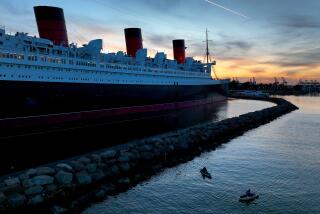Sea of Difference in Prices for Ship Items
- Share via
Question: I have some original ashtrays and other things from the Queen Mary. How much in demand would they be?--S.C.
Answer: Collectors abound who specialize in ocean-liner items. One catalogue lists the value of a plastic Queen Mary ashtray, estimated to be more than 50 years old, at $30. Other items from ships like the Queen Elizabeth and the United States--such as menus and photographs--range widely from a few dollars to $100 and up.
As you might guess, items associated with ships--such as the Titanic--that were involved in disasters generally command higher prices.
Q: In my Americana collection, I have some original advertising artwork that is decidedly frayed and, in some cases, torn. What do you suggest in terms of repair techniques?--E.M.
A: As a result of conversations with collectors and dealers, we’re coming to believe that unless great care is taken, no repair is a good repair.
Veteran collectors warn that your chances of harming the item--and thereby reducing its value--are high and that you’re probably better off leaving the paper alone.
There are, of course, exceptions such as one might expect in expert repairs performed on valuable books. But otherwise, collectors tend to take the view that trying to repair flaws in paper collectibles really doesn’t enhance value.
For example, if you have a valuable old map with a hole in it, it might be very difficult to match the paper quality. What you could be left with is a glaring patch that further detracts from the map’s market value.
If you want to try to clean dirt off a paper collectible, you may have to calculate the paper’s grade and whether it can stand up under a cleaning solution. And if the document is particularly valuable, you’re better off paying for the services of a professional restorer such as you might find associated with the bookbinding industry.
Q: We discovered an old television set in the attic. What are some ways to determine its age?--F.D.
A: Here’s a rule of thumb we found in “Warman’s Americana & Collectibles” (Warman Publishing Co., P. O. Box 26742, Department AC, Elkins Park, Pa. 19117, $12.95 plus $1.50 postage):
“The easiest way to gauge the age of a television set is by the numbers found on the channel selector. Pre-1946 television sets will tune a maximum of five stations, usually channels 1-5. In 1946, channels 7-13 were added, thus sets made between 1946 and 1948 will show channels 1-13 on the station selector.
“In 1949, Channel 1 was dropped, leaving all 1949 and newer sets with VHF channels 2-13, as we have them today. The UHF band was added in 1953 . . . .”
Interestingly, this particular catalogue places a high value on the early mechanical TV sets manufactured between 1925 and 1932. Depending on condition and whether most of the original parts are intact, prices range up to $4,000 per set.
But even as we approach the modern era, there are relatively rare sets that bring prices of several hundred dollars, according to the listing. And a CBS/Columbia “color wheel” set, probably produced in the late 1940s, has a $5,000 price tag!
Early companies listed by this reference work include Jenkins, Baird, Western Television, Insuline Corp. of America, Short-Wave and Television Corp., Daven, See-All, Rawls, Pioneer and Travler Radio & Television Corp.--none of which have survived as household names. Many of their products, this reference work says, were simply “visual attachments to radios.”
It’s noted that few of these brands were marketed in the West, so the interested individual may find the best hunting grounds among Eastern dealers and collectors.
The National Fantasy Fan Club announces a meeting at the Grand Hotel in Anaheim, July 19-21 to tie-in with Disneyland’s 30th birthday party. Details: Send a stamped, self-addressed envelope to National Fantasy Fan Club, P. O. Box 19212, Irvine, Calif. 92713.
Ronald L. Soble cannot answer mail personally but will respond in this column to questions of general interest about collectibles. Do not telephone. Write to Your Collectibles, You section, The Times, Times Mirror Square, Los Angeles 90053.
More to Read
Sign up for The Wild
We’ll help you find the best places to hike, bike and run, as well as the perfect silent spots for meditation and yoga.
You may occasionally receive promotional content from the Los Angeles Times.






